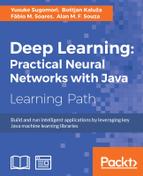In this chapter, we continue to look through the algorithms of deep learning. The pre-training that was taken into both DBN and SDA is indeed an innovative method, but deep learning also has other innovative methods. Among these methods, we'll go into the details of the particularly eminent algorithms, which are the following:
- The dropout learning algorithm
- Convolutional neural networks
Both algorithms are necessary to understand and master deep learning, so make sure you keep up.
In the previous chapter, you learned that layer-wise training with pre-training was a breakthrough for DBN and SDA. The reason why these algorithms need pre-training is because an issue occurs where an output error gradually vanishes and doesn't work well in neural networks with simple piled-up layers (we call this the vanishing gradient problem). The deep learning algorithm needs pre-training whether you want to improve the existing method or reinvent it—you might think of it like that.
However, actually, the deep learning algorithms in this chapter don't have a phase of pre-training, albeit in the deep learning algorithm without pre-training, we can get a result with higher precision and accuracy. Why is such a thing possible? Here is a brief reason. Let's think about why the vanishing gradient problem occurs—remember the equation of backpropagation? A delta in a layer is distributed to all the units of a previous layer by literally propagating networks backward. This means that in the network where all units are tied densely, the value of an error backpropagated to each unit becomes small. As you can see from the equations of backpropagation, the gradients of the weight are obtained by the multiplication of the weights and deltas among the units. Hence, the more terms we have, the more dense the networks are and the more possibilities we have for underflow. This causes the vanishing gradient problem.
Therefore, we can say that if the preceding problems can be avoided without pre-training, a machine can learn properly with deep neural networks. To achieve this, we need to arrange how to connect the networks. The deep learning algorithm in this chapter is a method that puts this contrivance into practice using various approaches.
